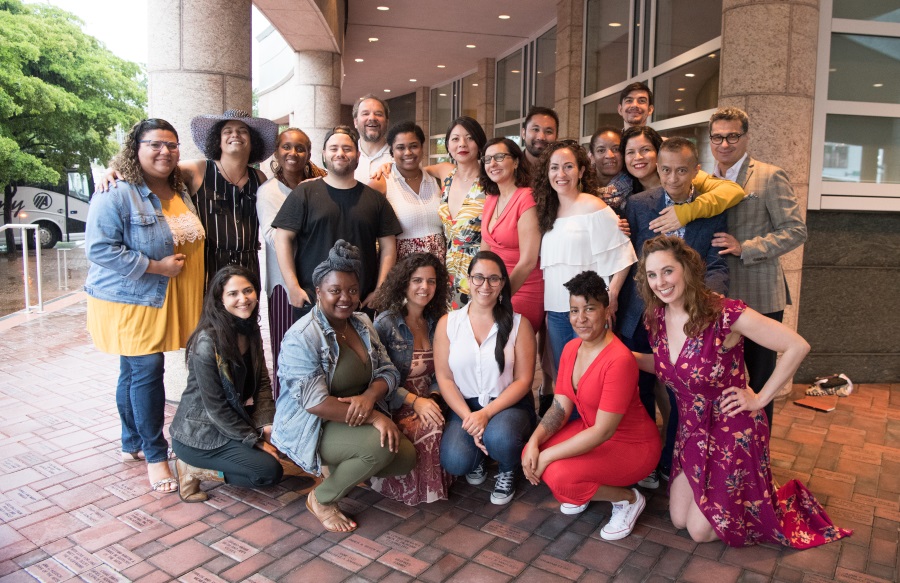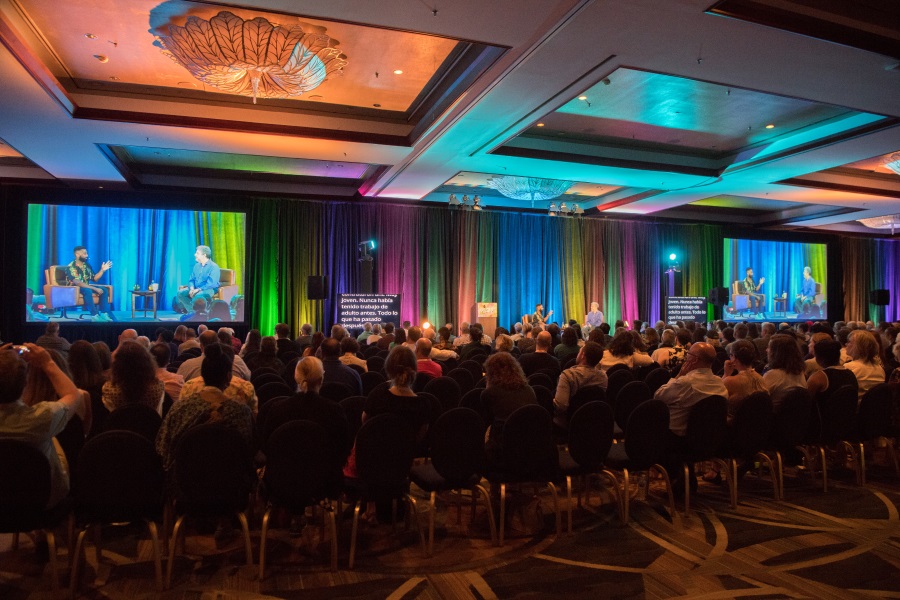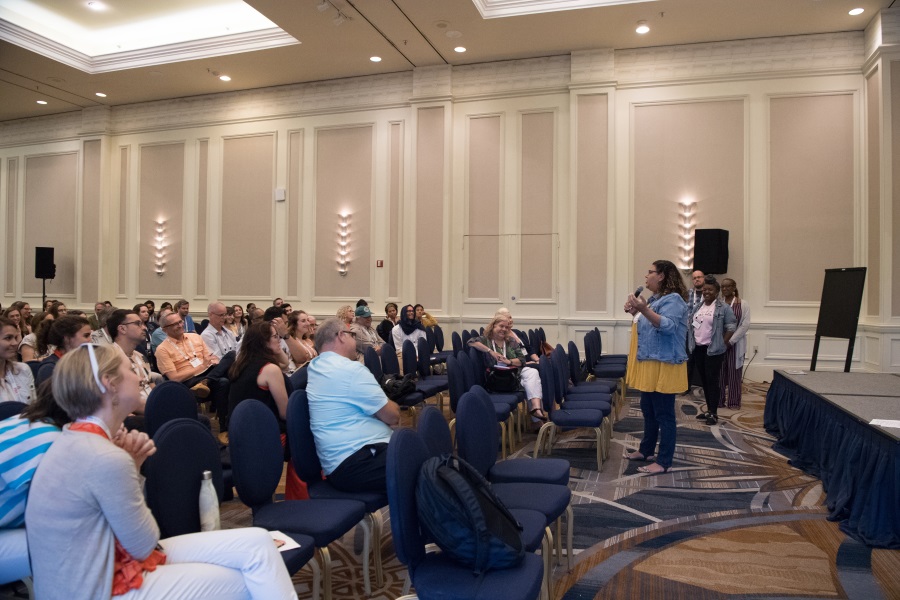I am a woman.
I am a young Cuban American.
Can someone who looks like me have an educated opinion in the theatre? I want to restructure that question because I know the answer (yes). It ought to read: Is someone who looks like me allowed to have an educated opinion?
You are more than you’ve been told.
You are more than you’ve been told.
That mantra, shared by a fellow Rising Leader of Color, Jordana De La Cruz, helped me get through a lot of TCG’s National Conference, held here in Miami, June 5-7 (I’m one of a cohort of 10 theatremakers). I reminded myself that I did not have to give up a part of myself to become something else. I am enough. On top of being a proud Hispanic woman of Cuban descent, I am a theatre professional who is extremely passionate about the arts.
Being a woman of color is not an easy thing to be in our world. But I think that what some people perceive as a weakness is actually my strength. The truth: I want to be an advocate for the theatre as a worthwhile art form. I want to be an ambassador for the work we do as artists. Long after the set is struck, the theatre journalist is the one who can make sure the work does not disappear once the night is over.

A Head Start
Though the TCG conference officially started in the first week of June, for cohort 4 of Rising Leaders of Color, the program began almost a month earlier at the Koubek Center at Miami Dade College. Led by Emilya Cachapero, director of TCG’s artistic and international programs, in May we did workshops on equity, diversity, and inclusion with Elena Chang, director of TCG’s EDI Initiatives. Just prior to the main conference, Paul Robinson, former director of the James P. Shannon Leadership Institute, led leadership training on values clarification and an immunity to change workshop. This was followed by a workshop with Stephen Buescher, actor, director, and teacher, titled “Bringing It With You: Visions, Voices, Vocation,” in which participants explored how we unapologetically and consistently bring ourselves and our life experiences to our work.
Among the many things we discussed during those days together, one thing floats to the top of my mind. When Robinson first said, “You can lead from any chair,” I quickly jotted it down in my notebook to remind me that leadership is not a title—it’s a way of thinking and behaving that empowers the people around you. But first we must align our actions with our core values. It seems simple enough, but it falls under the category of “easier said than done.” I made a promise to myself at that moment to identify and work toward my core values. At the top of my list is doing meaningful work. I know that transformative dialogue about the arts can have a meaningful social impact, collectively coexisting and embracing diversity in all its forms.
 Getting My Arms Around It All
Getting My Arms Around It All
Hugs. Hugs were something that I did not expect to experience in such frequency at the TCG conference. I received them from many people who work with local theatres. Many said how glad they were to see a woman of color as a journalist in their community. I was also embraced by people from elsewhere. I particularly remember a woman from New Orleans who said there were only two people writing about their theatre scene, neither of whom were people of color, and that they recently lost another of their writers when the local newspaper was bought out.
As I entered each room, I thought about what a responsibility it was to take space in them. Theatre journalists can be advocates, educators, and documentarians. I want to be all of the above. This leads me to questions such as:
How are we cultivating critics of color?
How can we nurture local voices?
How can we fortify our community?
What role does theatre journalism have in the theatre now?
The late Maria Irene Fornés, one of our best American playwrights, was quoted saying, “We can only do what is possible…but still, it is good to know what the impossible is.” I know what I have seen, but as I entered each session, I began to think: impossible? I think not. I feel hopeful that theatre journalism can contribute to the public good.
One of the conference’s three tracks was the state of arts journalism, and I attended several of these. All were about opening the conversation around theatre journalism and the art form itself; many questions were left unanswered, but I was happy to be in the room where they were being asked. I found myself with journal in hand, trying to scribble down every piece of knowledge and advice I could gather. I was there to learn. I am hungry for knowledge.
When I stepped relatively recently into the role of theatre journalist, I did not realize the crisis surrounding journalism and the arts. I discovered that there is a very adversarial relationship between artists and theatre critics. One of the most fundamental questions discussed was: Why are they mean to each other? I also wondered how could we might serve as historians of the art form.
The theatre journalism programming track included an all-conference plenary session with Wesley Morris, critic at large for The New York Times, in conversation with Todd London, director of theatre relations for the Dramatists Guild. The conversation was insightful and made me question what might be next for the theatre journalist—and for the theatre.
I also attended a lab facilitated by Brian Herrera, associate professor of theatre at Princeton University and resident scholar for the Sol Project, and Regina Victor, founder of the Chicago site Rescripted.org. This session was facilitated through group discussion and brainstorming on the purpose and the potential of theatre criticism and journalism in 2019. The most exciting conversations circled how reviewer’s and journalists might become better collaborators with artists and institutions about whom they write.
A similar theme was part of “Getting on the Same Page: Journalists and Artists Revisit Our Common Values.” Moderated by director/critic Isaac Butler, the conversation envisioned the possibility of a stronger future for both theatremakers and journalists by maintaining the common spark of their love of theatre. Artists and journalists alike are finding their jobs hard to sustain, so how can they strengthen and find ways to collaborate and complement each other rather than compete? Also on the panel were Christine Dolen, longtime Miami critic, who’s currently writing for Artburst Miami; Dámaso Rodriguez, artistic director of Portland, Ore.’s Artists Repertory Theater; Atlanta journalist Kelundra Smith; playwright Regina Taylor; and Chicago critic Kris Vire.
I was eager to listen to the questions asked at the live Offscript podcast with American Theatre‘s editors. Dolen was also on hand for this conversation, which included local theatre leaders Joseph Adler (GableStage) and Mario Ernesto Sanchez (Teatro Avante, International Hispanic Theatre Festival), discussing trends in Miami’s theatre landscape.

Questions, Not Opinions
Criticism and theatre journalism have gone through huge shifts. It’s clear to me that we need to communicate better with the artists we cover, and with our audiences. There were many other nuggets of knowledge I gleaned, not specifically directed at the subject of theatre journalism but which I nevertheles found applicable. At one point Robert Barry Fleming, the new artistic director of Actors Theatre of Louisville, asked those gathered for an artistic director’s summit, “What if theatre were socially accountable—accountable to our society in different ways?”
We were faced with many questions, both as critics and as theatre lovers, throughout the conference. As a journalist, my goal will be to lead not with an opinion but with questions. One thing I won’t question any more, however: my worthiness.
You are more than you’ve been told.
You are more than you’ve been told.
I am a woman.
I am a young Cuban American.
I am a writer.
Cristina Pla-Guzman, a writer and educator based in Miami, is among this year’s TCG Rising Leaders of Color.


